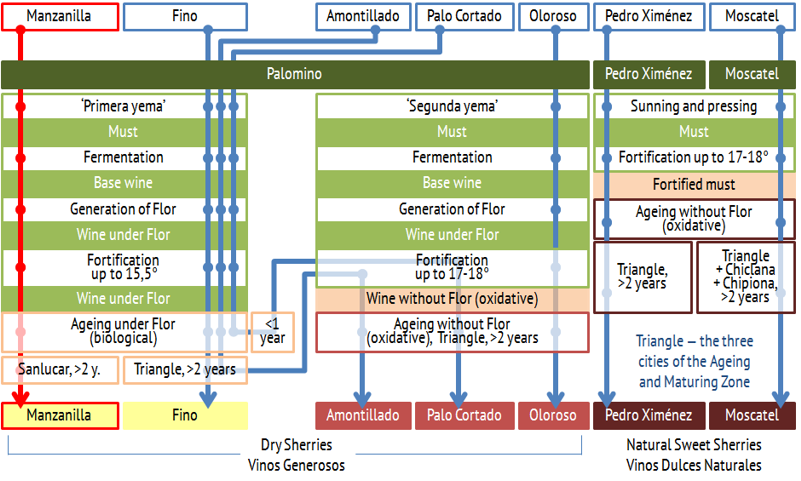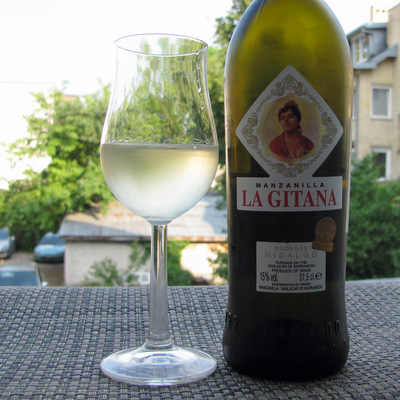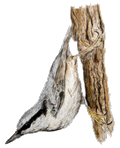
- Sherry Wine:
- Production
- Classification
- Cities & Bodegas
- Tastings
- Analogues
- Authors & Contacts
- Ðóññêèé ñàéò
Sherry wine types
Manzanilla
Olga Nikandrova and Denis Shumakov.
Manzanilla is a dry biologically-aged sherry. It’s main distinction is its strict association with only one town — Manzanilla may be aged only in Sanlúcar de Barrameda.

In technical aspects Manzanilla is very much similar to Fino. Or Fino is similar to Manznilla — it does not matter at the moment. What matters is that many technological details in the production of these two drinks are absolutely the same.
First extraction must of Palomino grape is used to make the base wine which is to become Manzanilla after ageing. The base wine with a veil of flor on the surface is fortified up to 15-15,5°. The wine is aged under flor in the Criaderas and Solera system two years minimum (mostly longer). That is everything almost as is done with Fino. But for some nuances. Which are the place and the dinamic of ageing.
Manzanilla, again, is kept under flor for minimum two years in Sanlúcar de Barrameda. In this only the fact of its ageing in the particular place is critical — grapes for the wine may be collected in any part of the Jerez Region. Nevertheless, there are vineyards which are considered better suitable for this wine — for example, the vineyards located closer to the ocean.
The choice of the particular town for Manzanilla ageing has delicate but essential grounds. Despite the fact that Sanlúcar de Barrameda is located in only a couple of dozen kilometers away from other town of the Jerez Region, its climate differs from the ones in Jerez de la Frontera and El Purto de Santa Maria significantly. And it is not only for the Guadalquivir, which meets the Atlantic Ocean near the town, swamps part of the territory and notably softens the climate. El Puerto de Santa Maria, for example, also has a river and swamps nearby. It is also for the fact that Sanlúcar lies in two levels — and the upper level of the town stops moist winds from the ocean and retains them over the lower level of the town.
So fortunate wet and mild climate is enhanced by the orientation of bodegas (from north to south, with windows to the west, where the moist wind blows from), which creates perfect conditions for the growth of flor. The latter develops absolutely unassisted on the wine’s surface in Sanlúcar de Barrameda (in the other towns it is often purposely introduced into barrels), grows sustainably and rapidly and does not hibernate (as it does in the other towns.
Flor’s intensive life during biological ageing requires more frequent addition of new wine into criaderas than in the other towns (with fresh wine flor receives nutrients which it needs in large amount and diversity). The necessity to more intensively refresh the wine combined with the required minimal ageing period results in the fact that the number of criaderas in Sanlúcar’s bodegas is bigger than in the other towns (may be 11-16 of them, e.g.). Of course, all this has a very strong effect on the character of the wine.
It’s alcoholic content turns out to be 15-17° with sugar content less than 5 grams per liter (these formal characteristics of Manzanilla are similar to the ones of Fino). Color is from straw to golden yellow. The wine has a characteristic spicy aroma with notes of ripe fruit and wild flowers; a light, dry, gently-structured taste with low acidity and a delicate, fresh aftertaste with marine tones.
Manzanilla’s closest neighbor in the sherry line is Fino, their main differences are described above. There are also some sherry specialties produced on the basis of Manzanilla.
1. Manzanilla Pasada. It is a long-aged Manzanilla where flor has almost completely died of the lack of nutrients. When expiring flor nourishes the wine with different nice (and, they say, healthy) elements. Such wine is usually a little darker than classic Manzanilla (as oxidative processes have already started there), its taste is a bit denser and velvety with pleasant downbeat notes. To have the name Manzanilla Pasada on the label, the wine must go through the Regulatory Council’s certification.
2. Manzanilla en Rama is the wine which did not undergo the full procedure of filtering and clarification after being taken from solera and before bottling. The modern fashion for non-filtered sherries has started from Manzanilla.
3. Manzanilla Amontillado is a long-aged Manzanilla where flor has died of natural causes — due to the lack of nutrients. Biological ageing has stopped and oxidative ageing has started here, but it lasted a short time. The actual difference between Manzanilla Amontillado and Manzanilla Pasada is very small and lies in the fact that there is some very feeble but still alive flor in Manzanilla Pasada and none of it alive in Manzanilla Amontillado.
It is noteworthy, that the producers of Manzanilla make an impression of people and companies who are apt to experiments and creation of exclusive products more than their colleagues from other sherry towns. Different tricky wine — same En Rama or Single Vineyard Manzanillas, for example, would be found in Sanlúcar more frequently than at neighbors.
Manzanilla is the most popular sherry in Spain. And, as we understand, most of it is consumed directly in Andalucía. In terms of world sales volume, Manzanilla is only on the forth place among sherries.

Manzanilla against the Vilnius skies background
Manzanilla in Spanish means chamomile. Notes of fresh chamomile in the aroma is one of generic indicators of Manzanilla. Or, in simpler terms, Manzanilla smells of chamomile. And this is wonderful.
From a consumer’s point of you as well as technically Manzanilla is very close to Fino. Just as Fino it is best to drink it from a special sherry glass or a white wine glass. And the choice of the glass for Manzanilla will also become irrelevant very soon (in the Jerez Region itself, sherry is often served in small cylinder-shaped glasses, they also have special small glasses for Manzanilla called caña). As well as Fino, Manzanilla is better served strongly cooled — drink it, observing how the taste changes with gradual warming of the drink. And, of course, do not cool Manzanilla en Rama too much. And still.
Manzanilla differs from Fino. It’s not only that Manzanilla is, as a rule, more delicate, subtle and chamomile. Or, that having just as high compositionality (goes well with sushi, soups, seafood, salads, smoked or salty food, nuts, olives and other things) Manzanilla is both gastronomically and geographically closer to the sea. The point is that, purely subjectively, Manzanilla is a more complex and more emotional drink (for unknown reasons), with more distinct terroir characteristicsñ (for reasons rather obvious) and a more pronounced physiological effect. Manzanilla has no rivals in its ability to gently and comfortably cool the human body overheated in Andalusian (or any other equal) heat.
It is assumed that Manzanilla should be consumed within a year and a half after it was bottled. To our mind, this recommendation is too general but noteworthy. Uncorked and closed again bottle of Manzanilla can be stored in the fridge for a week without any notable loss of quality.
By the way, we have completely forgotten to mention that Fino can also be produced in bodegas of Sanlúcar de Barrameda. Why not.
Manzanillas reviewed on the website (in Russian only):
— Lustau Manzanilla Papirusa
— Barbadillo Manzanilla en Rama Saco de Verano 2010
— Barbadillo Manzanilla Solear en Rama Saca de Verano 2011
— Barbadillo Manzanilla Solear
— Barbadillo Manzanilla Muyfina
— Manzanilla «La Guita»
— Manzanilla J. Martínez
— Marks & Spencer Manzanilla Sherry
— Manzanilla La Gitana
— Manzanilla Pasada Pastrana
— Manzanilla San León
— Barbadillo Manzanilla Solear en Rama Saca de Verano 2013
— Manzanilla Alexandro
— Lustau Manzanilla Pasada de Sanlúcar (Almacenista Manuel Cuevas Jurad)
— Manzanilla Macarena
— Pino Viejo Manzanilla En Rama
— Alexander Jules Manzanilla 17/71
— Equipo Navazos “I Think” Manzanilla En Rama Saca de Abril de 2016
— Manzanilla Riá Pitá
Read next — Oloroso
Warning!
This site can contain information about drinks excessive consumption of which may cause harm to health and is unadvisable for people who didn’t come of age.
Share Sherry
- Sherry.wine, FEDEJEREZ
- Copa Jerez, Sherry Week
- Sherry Notes, Jerez de Cine
- Los Generosos, Criadera
- Jerez-Xeres-Sherry
- Los Vinos de Jerez
Articles
- There are more articles in Russian than in English in this website. Sorry :(
Reviews
- To our great regret, we didn’t have time to translate tasting and traveling notes into English. But, if you want, you can see them in Russian.

